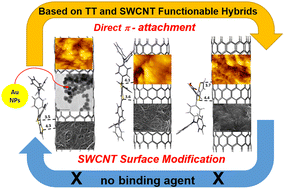Non-covalent modification of single wall carbon nanotubes (SWCNTs) by thienothiophene derivatives†
Abstract
Non-covalent functionalization of single wall carbon nanotubes (SWCNTs) has been conducted using several binding agents with surface π-interaction forces in recent studies. Herein, we present the first example of non-covalent functionalization of sidewalls of SWCNTs using thienothiophene (TT) derivatives without requiring any binding agents. Synthesized TT derivatives, TT-CN-TPA, TT-CN-TPA2 and TT-COOH-TPA, were attached directly to SWCNTs through non-covalent interactions to obtain new TT-based SWCNT hybrids, HYBRID 1–3. Taking advantage of the presence of sulfur atoms in the structure of TT, HYBRID 1, as a representative, was treated with Au nanoparticles for the adsorption of Au by sulfur atoms, which generated clear TEM images of the particles. The images indicated the attachment of TTs to the surface of SWCNTs. Thus, the presence of sulfur atoms in TT units made the binding of TTs to SWCNTs observable via TEM analysis through adsorption of Au nanoparticles by the sulfur atoms. Surface interactions between TTs and SWCNTs of the new hybrids were also clarified by classical molecular dynamic simulations, a quantum mechanical study, and SEM, TEM, AFM and contact angle (CA) analyses. The minimum distance between a TT and a SWCNT reached up to 3.5 Å, identified with strong peaks on a radial distribution function (RDF), while maximum interaction energies were raised to −316.89 kcal mol−1, which were determined using density functional theory (DFT).



 Please wait while we load your content...
Please wait while we load your content...